
Habitat Garden
in the Richmond District
The homeowners came to us looking to convert their Richmond district garden into a space where their family could grow. They were conscious of the impact their garden had on the environment and the role it would play in our urban ecology.
We first created a layout that optimized sun, privacy, and protection from wind in the garden’s seating areas. A freeform layout mimics the natural forms of the greater landscape.
A long stretch of decomposed granite provides access throughout the garden while doubling as a petanque court.
The only plant we kept was the mature lemon tree, which gives abundant fruit and provides a shaded area to explore for those who can fit.
A selection of plants was made based on suitability to the site’s sandy dune soil and coastal climate. Plants like Coyotebrush, Pacific reed grass, and Salt bush are found growing in chaparral areas all along the California coast.
More exotic species from the protea family that prefer fast draining soil were welcomed into the mix, many of which add year-round color with their vibrant foliage.
Native Lupine and monkeyflower mingle over a bed of coastal strawberry.
A figure eight sidewalk often found in original richmond/sunset gardens was saw cut into blocks, then stacked and mortared into a raised veggie bed. Other sections were reused to create a landing for a potting bench and barbecue.
Beyond the veggie bed, perennial fruiting plants like fig, olive, and pineapple guava are mixed in with ornamentals.























